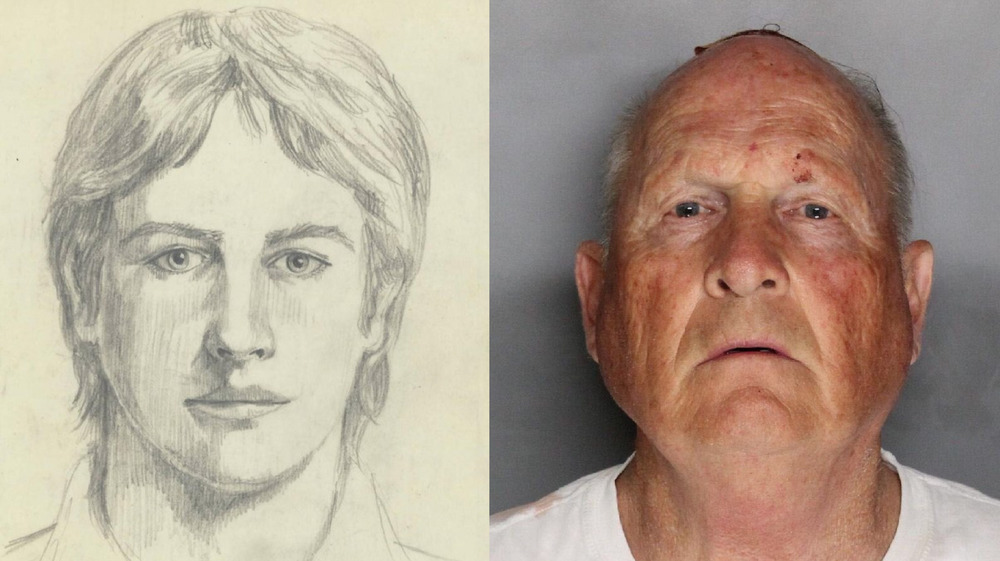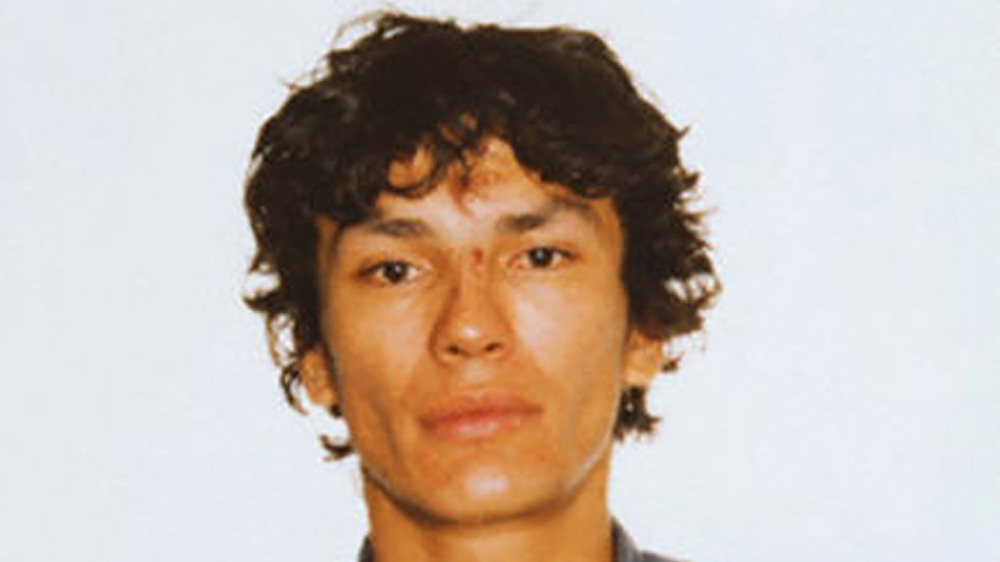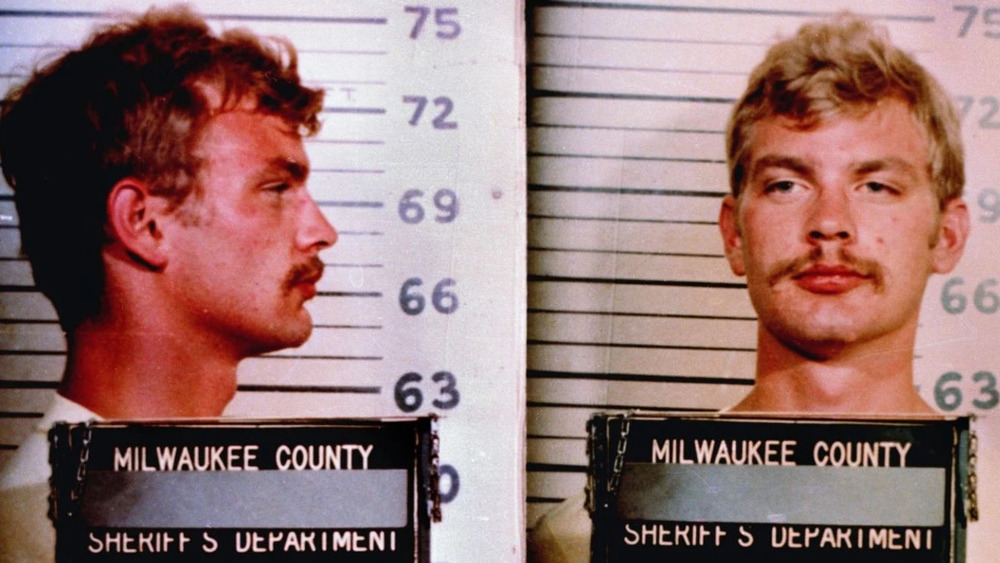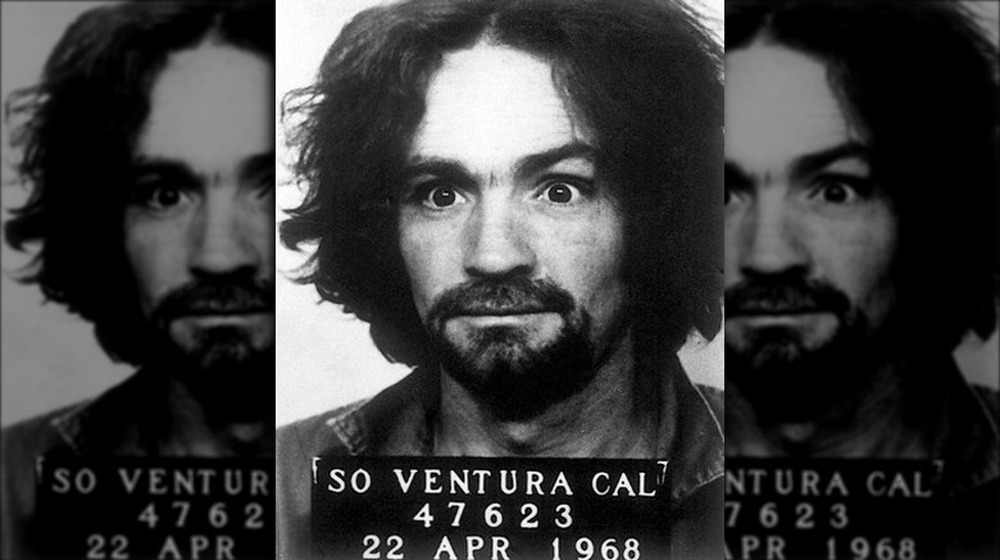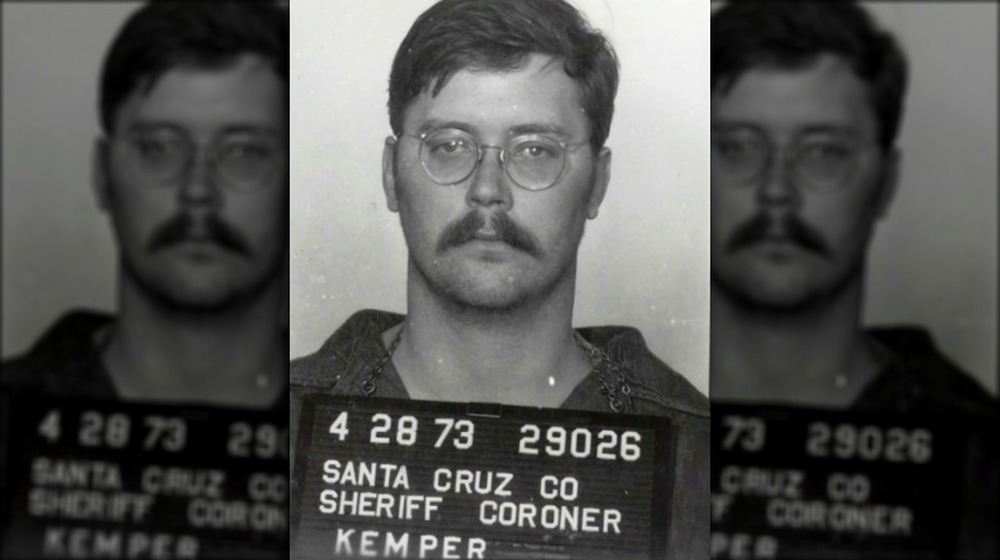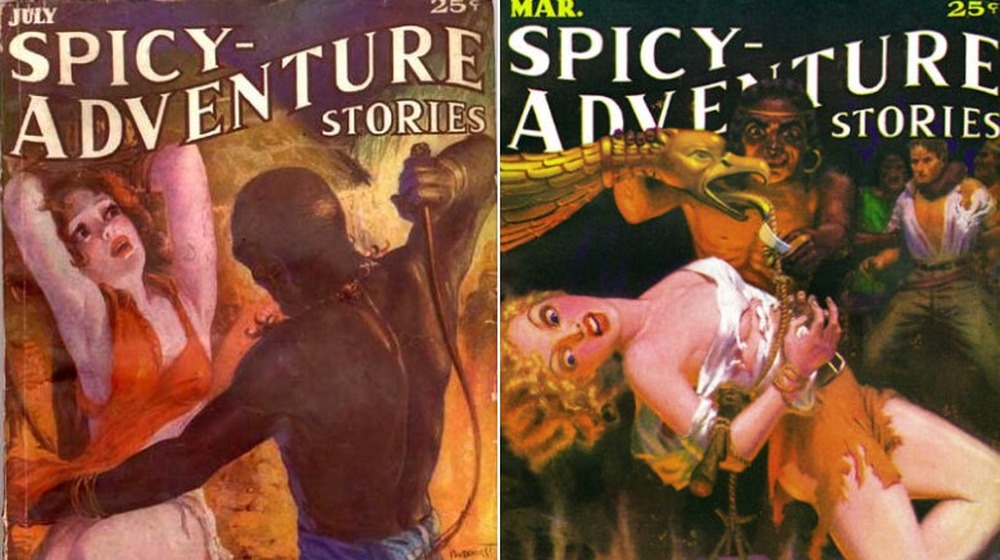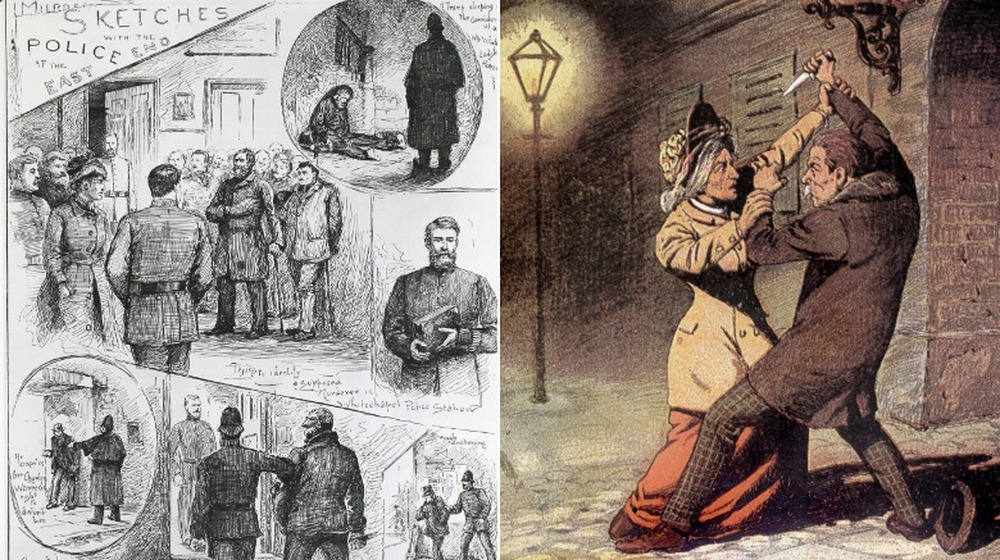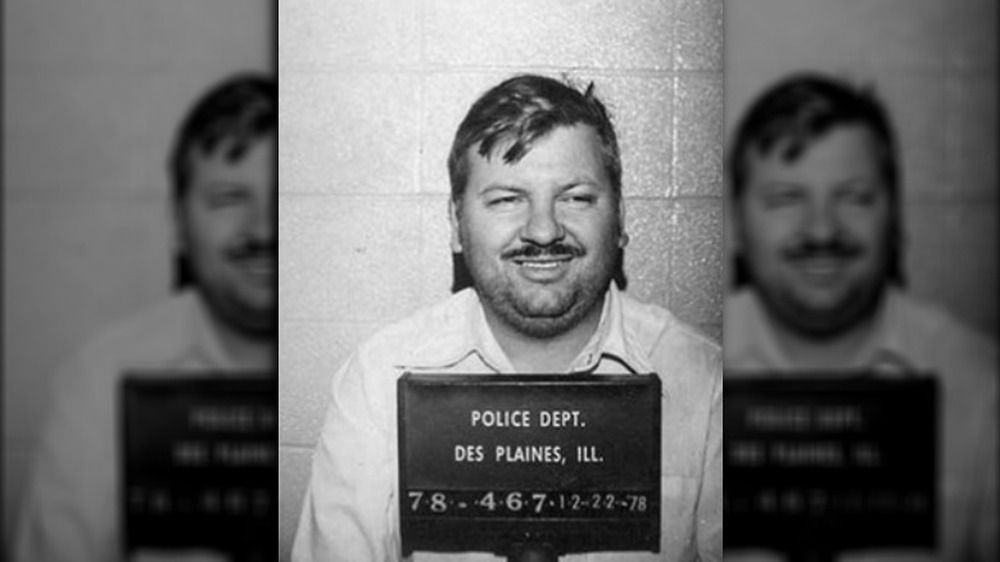These Countries Have The Most Serial Killers. Here's Why
Humans are strange creatures for a whole host of reasons, and among the weirdest is the fascination with those who kill their fellow humans. According to the BBC, our fascination with killers is nothing new. When William Corder was executed for the 1828 murder of his lover, his misdeeds — and ultimate fate — weren't just fictionalized and presented to the public in plays and puppet shows, but parts of his body were on display, too. Thousands of people turned up to watch him die, and for weeks afterwards, a nearby London shop attracted customers by displaying a grisly piece of memorabilia: his ear and a piece of his scalp.
For as long as we've been trying to stop serial killers, we've been fascinated by what makes them tick. Those who interview them — like forensic psychiatrist Helen Morrison, who's interviewed more than 80 American serial killers — say they're invariably, bizarrely charming: "like a Cary Grant or a George Clooney."
Still, it's a weird thing, and it turns out that even though the serial killer is a worldwide phenomenon, there's definitely countries that have given birth to way more than their fair share of these inexplicably fascinating criminals. In fact, there's two countries sitting way, way above the others... so let's talk about them, and why they're such ripe hunting grounds.
What countries are we talking about?
There's an old saying about things being as American as apple pie and baseball, and statistics suggest that serial killers could also be added to that list. When it comes to the countries with the most cases of these particular kinds of criminals, there's no other nation that even comes close.
According to World Atlas, almost 68 percent of the world's serial killers are found in the US. That's only part of the story though, so let's talk about actual numbers. They say that the number of serial killers in the United States is 3,204, and while that's obviously a lot, it seems like even more when it's compared to the country that comes in second. That's England, who's credited with just 166.
That's a huge jump, so let's just let that sink in for a minute. The numbers continue to drop off pretty quickly: South Africa is in third place with 117, Canada comes in fourth with 106, and by the time we get to fifth place, we're in double digits. Italy has just 97 (and Japan follows close behind with 96), but what the heck, America? That breaks down to 0.99 serial killers per 100,000 people, so clearly, there's something going on here.
Changing social factors and the golden age of serial killers
Ted Bundy, Charles Manson, Jeffrey Dahmer, Richard Ramirez (pictured)... their names are among the most well-known of America's serial killers, and they were all active during a period that's often called the "golden age of serial killers," which is generally between the early 1970s to the late 1990s. Discover Magazine says that in the 1980s alone, there were almost 770 serial killers at work across the US — and that's pretty shocking stuff. There's obviously no single — or simple — explanation for the surge in serial killers, so let's just pick somewhere to start: with social change.
James Alan Fox is a criminologist with Boston's Northeastern University, and he spoke to the BBC a little bit about what was going on in America to contribute to the rise in serial killers. Part of it, he says, was the fact that throughout the US and Canada, there was an overall uptick in all crimes. Plus, there were no large-scale databases like we have today, and the term "serial killer" was still pretty new and ill-defined. Coupled with the widespread and potentially deadly trend that was hitchhiking, and the result, Fox says, was essentially "an environment which was ideal for certain killers to prey on victims."
Fox also says that as society changed, hitchhiking became less common, and a major source of easy victims declined. Serial killers also started to decline, but it definitely wasn't the end of them.
Serial killers thrive in a 'society of strangers'
The presence of serial killers in a society doesn't just require the killer him- or herself, it also requires a particular set of circumstances that University of Alberta professor of sociology and criminology Kevin Haggerty argues (via the Centre for Crime and Justice Studies) have only appeared in modern times. One of his requirements for the birth — and success — of serial killers is one that should sound familiar in 21st century America: a "society of strangers."
Haggerty says that for centuries, people were born in, lived in, and died in the same area, surrounded by the same people that they'd known their entire lives. (And that's still the case in some countries.) More recently, the rise of city centers has caused a few things to happen, including the mass movement of people to urban areas, and the faceless anonymity that comes with being surrounded by hundreds upon hundreds of strangers on a daily basis.
Imagine, for a minute, the big cities of the US. New York City in particular lauds itself on the hustle and bustle of thinly veiled chaos, where literally millions of people shove their way past each other every day. Serial killers thrive on what Haggerty calls "routinized impersonal encounters," and the fact that these encounters happen all the time, every day, in cities — and towns, and villages — across the US make for prime hunting grounds where serial killers can pick and choose their victims.
Celebrity serial killers and better reporting
World Atlas suggests there's a super simple reason that there's so many more serial killers in the US and the UK than in other countries, and that's because their law enforcement agencies are simply better at keeping records, reporting crimes, and linking murders that are committed by the same person. There is likely something to the theory: countries like Russia, for example, would probably have much higher numbers if serial killers were more likely to be reported on a global scale.
It seems like that's something that should be reported, but experts also suggest publicizing these killers is something of a double-edged sword that's given rise to the so-called celebrity serial killer.
According to University of Alberta professor of sociology and criminology Kevin Haggerty (via the Centre for Crime and Justice Studies), the real rarity of serial killers gets a little lost thanks to how often they show up in the media and pop culture. People across the country read everything they can about the Golden State Killer, they wonder if they'll be the one to crack the codes and clues left by the Zodiac Killer, and referred to Ted Bundy (pictured, in court) as handsome. Serial killers are no longer only about their actions, they're about the cult of personality: America's mass media and pop culture landscape have made serial killing a legit route to fame and celebrity status, and that's a very strange thing, indeed.
How the Great Depression created a surge of serial killers
Author and historian Peter Vronsky has been studying the cultural and environmental factors that contribute to the development of serial killers since his own literal brush with one: he walked past Richard Cottingham, the Butcher of Times Square, as he was leaving a motel where he'd committed a double murder.
Vronsky suggests (via CrimeReads) that there were several periods in American history that were perfect for laying the groundwork — and the troubled childhoods — of future serial killers. The first was the Great Depression, and he points to the sheer number of killers who were born at the tail end of it, including John Wayne Gacy, Charles Manson (pictured), and Henry Lee Lucas.
Vronsky says that there's two parts to the story, and first, there's the complete disintegration of the social structure that America had been built on. For generations, men had been the breadwinners of the family, there had been clear divides between the haves and the have-nots, and everyone knew just what place they occupied. But then, World War I sent broken soldiers suffering from countless undiagnosed and untreated mental issues back to America, where they tried to build something resembling a family... and it was just in time for the Great Depression to take it all away. Men like Gacy and Manson were born into those families thrown completely in turmoil... and they were surrounded by the newly homeless, poor, and transient. In other words, victims.
World War II and serial killers
After World War I and the Great Depression turned American life upside-down, there was World War II. Author and historian Peter Vronsky says (via CrimeReads) that there's a few things that happened around the war years to help give rise to America's golden age of serial killers, starting with a phenomenon that was a repeat of what happened during World War I: men with untreated mental illness who returned from the war to try to start a family, while dealing — alone — with all they'd seen and done. Future serial killers like Ted Bundy, Edmund Kemper (pictured), Dennis Rader, and William Bonin were just a few born in the immediate post-war years, and Vronsky argues that it was a difficult way to grow up.
In addition to growing up under the oppressive weight of trauma that families just didn't talk about, pop culture was changing, too. Film noir — and a group of movies that The New York Times described as "homicidal" put that violence front and center for young people already struggling, and young men grew up watching — and experiencing — a gender shift, too. There were femme fatales on the silver screen and empowered women who'd had their first taste of independence and a life outside of the home during the war years, which all helped nurture dark psyches... then give them a target.
Literature put death and torture front and center
It's easy to brush aside the traumatic, cumulative effects that the Great Depression and two world wars might have on someone born in the years after World War II, but Vronsky has some compelling evidence: including the fact that he told Vice that 82 percent of US serial killers were active during that so-called "golden age." Vronsky took some of these serial killers and backtracked into their formative years. While most didn't start killing until they were approaching their 30s, he found that many would have been starting down their path much earlier — for golden age killers, that would have been in the 1940s and 1950s.
At that time, Vronsky (via CBC) says they would have grown up reading magazines called "sweats," so named because they featured a style that graphically depicted pain, torture, and abuse. Within the pages of these magazines — which were readily available everywhere from the corner store to the local barber shop — were stories of mutilation, murder, sexual assault, and bondage porn.
While it might sound like a knee-jerk reaction of blaming pop culture for creating monsters, it's worth noting that these magazines were frequent finds in the homes and apartments of serial killers that were finally brought to justice. One — Harvey Glatman — was active in the 1950s, and photographed his victims as the women on the covers of True Detective magazine. He kidnapped them, posed them, then killed them.
Jack the Ripper, penny dreadfuls, and the British imagination
Significance suggests that part of the reason the UK has so many serial killers is their obsession with their most famous unsolved crimes: the murder spree of Jack the Ripper. The Ripper's name might be a mystery, but the names and fates of his victims were immortalized in everything from contemporary penny dreadfuls and puppet shows to modern television and film. The phenomenon is so big that researchers from Augsburg University suggest there's two Rippers: the real and the fictional. Both are possibly equally important, as they say the crimes of the Ripper were so popular they're actually linked to the rise in literacy rates the country saw in the 19th century.
They also introduced characters like Sweeney Todd, and serial killing became so fascinating that it caused the first official instances of copycat killing (and the coining of the term "copycat effect.") Other serial killers — like Dr. Thomas Neill Cream, who poisoned at least nine people — claimed to have taken their inspiration directly from the Ripper, making it a question worth pondering: what if there had been no Ripper?
Television personality, author, and all-around smart person Richard Osman has a further theory. He suggests (via CrimeReads) that the classically oppressive nature of British society, coupled with no access to guns, means that people spend a heck of a lot of time imagining how they're going to kill people, and that leads to serial killers so polite they're difficult to catch.
The US has a unique industry perfect for serial killers
Here's a not-so-fun fact that's the stuff of nightmares: according to The Atlantic, about 40 percent of serial killers get away with it. That's not a statistic from the 1980s, either; that's from 2019. So, how on earth — in the modern America, which is filled with social media, camera phones, and surveillance — is that possible?
They say there's a few things at work here, from the fact that serial killers are getting smarter and learning from their predecessors, to the idea that law enforcement is getting increasingly underfunded. There's also the fact that America has a massive industry that's perfect for serial killers: long haul trucking.
Between 2009 and 2019, the FBI identified 750 victims left along the nation's highways. Most of the suspects ended up being truck drivers, who were employed in a job that not only took them across state lines and made it easier to avoid law enforcement by crossing jurisdictions, but also presented a wealth of potential victims at places like truck stops and gas stations. Serial killers need opportunity, and America's trucking industry gives plenty.
There's been serial killers in every single US state
When it comes to serial killers, America is pretty equal opportunity in that every single state has had their share. Sure, some have more than others, but given that there's 50 states and every state has some, well, it adds up.
And that's just barely. According to Insider, Delaware has just a single serial killer. He was dubbed the Route 40 Killer, and was actively hunting sex workers within the period of the golden age of serial killers. Steven Brian Pennell was eventually arrested and found guilty for the series of killing that took place in 1987 and 1988, and when he was sentenced, he asked for the death penalty. He got it, and was executed in 1992.
State-by-state stories of serial killers show just how widespread they are. In Wisconsin, one was drafted by the Green Bay Packers in 1974. Pennsylvania had a 17-year-old serial killer, Rhode Island had a serial killer that started when he was 13, and there was a 19-year-old female serial killer in Florida. From East Coast to West, no US state has been without a serial killer making headlines at some point in history.
Here's the state that gives the US a lead
When it comes to states, which one has the most serial killers per capita, and why? (In other words, in which state are you most likely to become the victim of a serial killer?) California and New York might seem like logical choices, but it's neither of those — it's Alaska. According to Crime Capsule, Alaska's stats are staggering: for every one million people, there's 15.65 serial murders.
It's believed that there's a number of reasons why Alaska might be so attractive to serial killers, and it starts with the sheer remoteness of it. Not only are there vast expanses of wilderness that are perfect for disposing of a body, but the likelihood of being interrupted is slim, and law enforcement is forced to cover a huge amount of territory — which is difficult.
There's also a high percentage of seasonal workers that head to Alaska only briefly, then go off to greener pastures while the seasons change and the suspicion lessens. People who disappear from an ever-changing pool of workers are less likely to be noticed as missing, and the state also has a large percentage of sex workers — who are generally high-risk individuals and favored targets. All of that makes Alaska prime hunting grounds for serial killers.
